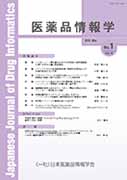Volume 18, Issue 1
May
Displaying 1-10 of 10 articles from this issue
- |<
- <
- 1
- >
- >|
Original article
-
2016 Volume 18 Issue 1 Pages 1-6
Published: 2016
Released on J-STAGE: June 13, 2016
Download PDF (543K) -
2016 Volume 18 Issue 1 Pages 7-12
Published: 2016
Released on J-STAGE: June 13, 2016
Download PDF (834K) -
2016 Volume 18 Issue 1 Pages 13-21
Published: 2016
Released on J-STAGE: June 13, 2016
Download PDF (509K)
Short communication
-
2016 Volume 18 Issue 1 Pages 22-32
Published: 2016
Released on J-STAGE: June 13, 2016
Download PDF (599K) -
2016 Volume 18 Issue 1 Pages 33-37
Published: 2016
Released on J-STAGE: June 13, 2016
Download PDF (785K) -
2016 Volume 18 Issue 1 Pages 38-45
Published: 2016
Released on J-STAGE: June 13, 2016
Download PDF (477K)
Note
-
2016 Volume 18 Issue 1 Pages 46-49
Published: 2016
Released on J-STAGE: June 13, 2016
Download PDF (306K) -
2016 Volume 18 Issue 1 Pages 50-57
Published: 2016
Released on J-STAGE: June 13, 2016
Download PDF (274K)
Infor-view
-
2016 Volume 18 Issue 1 Pages N1-N5
Published: May 31, 2016
Released on J-STAGE: June 13, 2016
Download PDF (1539K)
Series
-
2016 Volume 18 Issue 1 Pages N6-N11
Published: 2016
Released on J-STAGE: June 13, 2016
Download PDF (413K)
- |<
- <
- 1
- >
- >|
